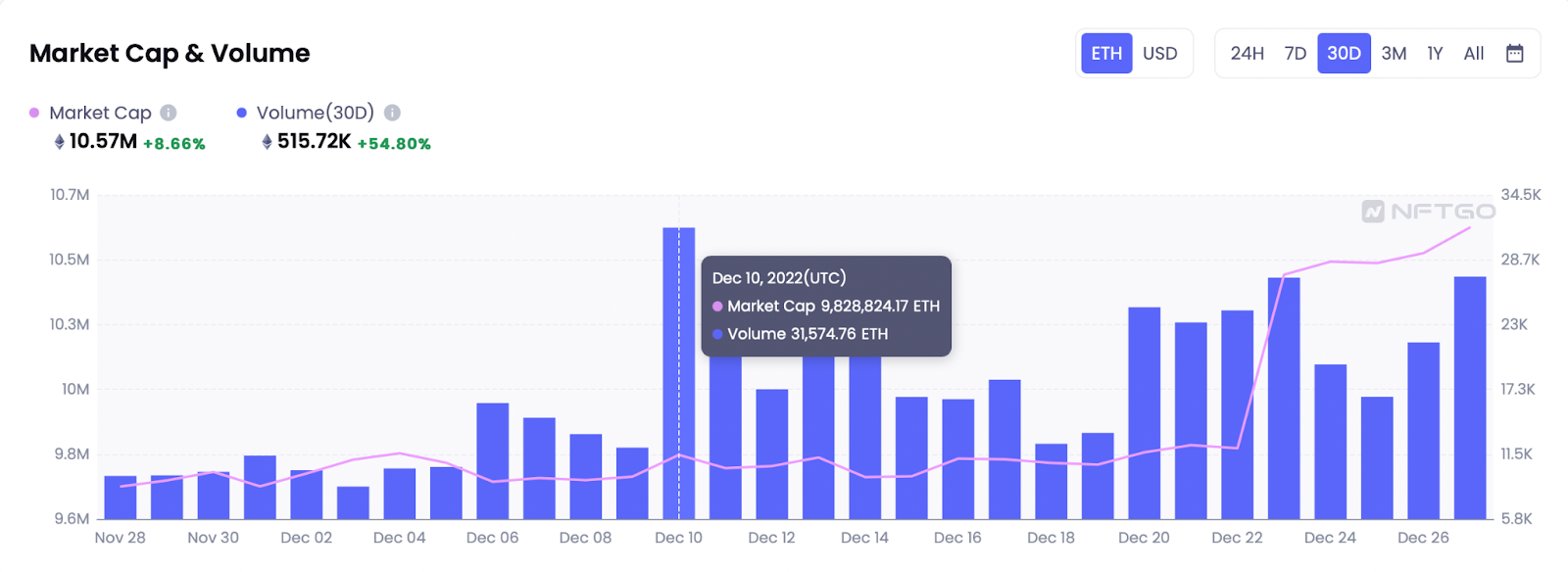NFTs may have taken a nosedive in popularity this year, but they haven’t completely left the chat.
Investor sentiment, driven by investor speculation, has cooled down since “panic” mode struck in May 2022 at the start of the bear market.
Weekly volume levels of marketplace activity exploded in January and remained elevated until the second week of May, when the Terra ecosystem crashed to zero. The second half of 2022 then saw both trading volume in ether and number of users gradually decline back to early 2021 levels, according to Blockworks Research.
But the trend changed markedly in December, a month of renewed activity thanks to a few popular projects, such as the Starbucks NFT loyalty program launching their beta and former US President Donald Trump’s NFT “trading cards” on the Polygon PoS chain.
Increased minting of gaming NFTs on ImmutableX, as well as Pudgy Penguins’ floor price flipping Doodles, are also notable events from this month. At the time of writing, Pudgy Penguins’ floor is 7.1 ETH and Doodles NFTs start at 6.9 ETH.
The year-over-year trend is still way down this month, however; Cryptoslam.io data indicates that global NFT sales generated $2.77 billion in December 2021. So far in December 2022, approximately $445.3 million has been registered in global NFT sales volume.
“I would say volume is pretty much non-existent since mid 2022,” said Blockworks research analyst Sam Martin. “You could even argue it’s been propped up thanks to new NFT marketplaces that people are trying to game to receive an airdrop like Blur or SudoSwap.”
SudoSwap’s creator royalty-free model sparked a massive debate on the value of NFT royalties when it arrived on the scene in August. Some marketplaces like Magic Eden tried a royalty-optional model before employing an open-source royalty enforcement tool, while OpenSea ended up enforcing royalties by blocking transactions with smart contracts associated with 0% royalty platforms.
In any case, Spencer Gordon-Sand, founder of NFT-focused fund Spencer Ventures, is “surprised and encouraged by how well everything is holding up” given that the industry is going through its first bear cycle.
“The fact that none of the top projects had significant direct exposure to the FTX blowup is insane,” referring to profile picture (PFP) projects such as Bored Ape Yacht Club or Azuki or Moonbirds.
Blur’s impact becomes clear
Dec. 10 actually marked the first time since May that there had been more than 30,000 ETH of volume. The director of research at Proof.xyz, NFTstatistics.eth, tweeted that over 70% of ETH volume occurred on the Blur marketplace for blue chip collections in particular.

“In the last year, a lot of people who were in the right place at the right time just rode the wave and got lucky,” Gordon-Sand added. “Now it’s much harder, but we are seeing the strongest founders rise to the top.”
Dibbs, a blockchain-enabled fractional trading card marketplace, recently commissioned an “NFT Sentiment Report,” which surveyed hundreds of NFT adopters. The survey found that 84% of respondents would purchase NFTs if they are redeemable for physical items.
This shows there is demand for collectibles with both physical and digital utilities, in addition to the NFT PRP asset class. Collections such as Nike’s RTFKT Cryptokicks iRL created sneakers with chips in them connecting the physical product to the digital asset via the RTFKT mobile app. Since launching on Dec. 11, the collection has generated 62.47 ETH or $7.5 million, according to OpenSea analytics.
If the December trend holds up in 2023, propelled by growing excitement for Web3, metaverse technology, further adoption of NFT loyalty programs and in-game digital assets, the NFT market may return to early 2022 levels of activity.
 blockworks.co
blockworks.co